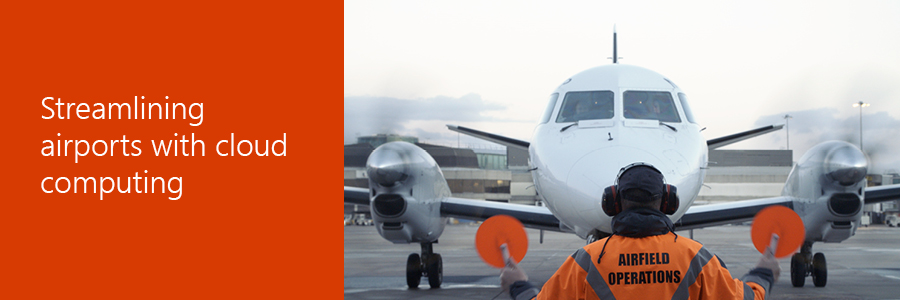Nobody likes a delay at the airport. Many of us have spent time buckled up, ready for takeoff, wondering why our plane is stuck on its way between the gate and the runway. Scientists in the United Kingdom are working hard to help untangle these airport operations, to help save fuel, money, and impact on the environment. Cloud computing is empowering the research team to parse the anatomy of these snarls and create a model that will one day recommend better paths for every plane.
Tim Walmsley, Environment Manager for Manchester Airport (opens in new tab), which is the third largest airport in the United Kingdom, handling over 23 million passengers per year explains:
Microsoft research podcast
Collaborators: Silica in space with Richard Black and Dexter Greene
College freshman Dexter Greene and Microsoft research manager Richard Black discuss how technology that stores data in glass is supporting students as they expand earlier efforts to communicate what it means to be human to extraterrestrials.
“Aviation is an industry that’s growing. So there are lots of ways that the industry is trying to tackle the impacts that growth could bring to the climate. The Airport Optimization Project feeds into that because we want to reduce the amount of CO2 that’s generated when an aircraft lands, taxis, and ultimately departs.”
One of the great understudied choke points at airports is the time aircraft spend taxiing to and from the runway. Sandy Brownlee, PhD (opens in new tab) , is a senior research assistant at the University of Stirling in Scotland who turned his computer science expertise toward this problem. He used Microsoft Azure (opens in new tab) to store data on thousands of taxiways at different airports and create open tools, now available to anyone on GitHub (opens in new tab), to model and improve aircraft taxiing to reduce pollution and improve efficiency. Jason Atkin (opens in new tab), assistant professor at the University of Nottingham, is Brownlee’s partner in their project with Manchester Airport, and also developed systems that are now streamlining operations at London Heathrow Airport. “One of the things cloud computing does is bring the power and data processing ability of huge machines to any researcher’s desk,” Atkin says.
Modeling required Brownlee to bring together data for dozens of airports from publicly available sources, including Flight Radar 24 (opens in new tab) and Open Street Map (opens in new tab). He was pleasantly surprised to find how easy it was to use open-source tools on Microsoft Azure (opens in new tab) , such as Linux virtual machines (opens in new tab), and developing his methods using OpenJDK (opens in new tab). Processing speeds using Azure enabled him to complete his work in one-tenth the time of just using his desktop computer. “So rather than spending several months waiting for my data to be ready so that I could get on and do things, I had it within a couple of weeks,” he says.
“Taxiing is a really critical problem because it connects everything else,” Brownlee explains. Many are familiar with strategies for aligning takeoffs and landings to improve safety or efficiency, but just imagine how the time spent slowly taxiing to or from the gate adds quite another layer of complexity to the puzzle.
One pilot can take longer than another to cover the same ground, traffic congestion can be heavy at busy times, and mechanical delays of any sort can throw off predictions. Taxiing delays ripple through the entire system, throwing off other timing. Modeling and predicting that taxi time can help airports change when and where they direct planes and yield big savings. Brownlee estimates modeling could help cut bottlenecks at Manchester in half.
But beyond bottlenecks, he also hopes someday the model will help guide decisions in weather emergencies or when a runway must be closed. Airports worldwide can use the modeling to understand what to do about a sudden change. “By getting more researchers worldwide involved … we could get a lot more benefit from different areas of knowledge all coming from the same problem,” he says.
The team applied for an Azure for Research award (opens in new tab) that let them explore how cloud computing could speed up their work, and it paid off by accelerating their analysis by several months. This enabled them to develop their open source tools on Microsoft Azure, apply their data science expertise to bigger datasets, investigate many more airports, and help set up models to make air travel more efficient and environmentally-friendly for us all. As a result, Tim Walmsley is confident that the future is bright for Manchester Airport, “As we embark on the 1-billion-pound project to transform our airport (opens in new tab), the Airport Optimization Project … will make sure we maintain efficiency, safety and the passenger experience.”
—Kenji Takeda (opens in new tab), Solution Architect and Technical Manager, Microsoft Research
Learn more
- Case study: Streamlining airports with cloud computing (opens in new tab) (PDF, 143 KB)
- Manchester Airport (opens in new tab)
- University of Stirling (opens in new tab)
- University of Nottingham (opens in new tab)
- Ground Movement Tools on Github (opens in new tab)
- Microsoft Azure for Research (opens in new tab)
- Linux and open-source computing on Microsoft Azure (opens in new tab)
- Microsoft Azure Open Source Hub (opens in new tab)
- Microsoft Azure (opens in new tab)






